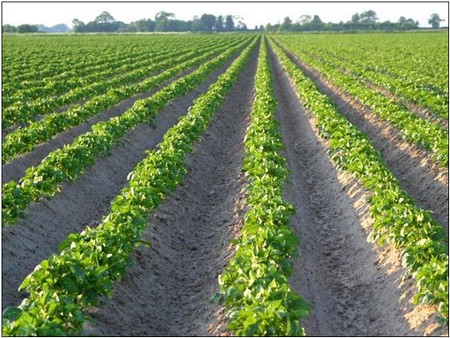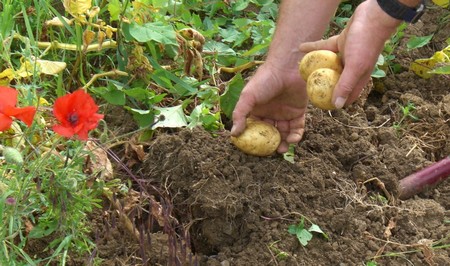The potato is one of the most important food crops in the world. The family to which it belongs, Solanaceae, is found worldwide, although the potato itself originates from a fairly restricted area in the Andes, spreading up into Mexico. There are many species involved in the botanical development of the potato, which is very complicated, and the history of the potato in cultivation is almost as complicated as its botanical history.
The potato has been grown as a vegetable in the Andes for thousands of years, and the Incas were discovered to be eating it by the conquering Spanish in the late 16th century. Taken to Italy, it eventually spread to the rest of Europe. The original cultivars were not particularly hardy, and it took a long time for the potato to catch on in northern Europe and two centuries before it was widespread in Britain.
The tubers – that is, the swellings on the roots – are eaten. All other parts, including the leaves and the fruit, are poisonous. It the potatoes themselves are exposed to light for any length of time, they turn green, and this, too, is poisonous unless cooked.
Potatoes are grown from “seed potatoes”. These are not seeds in the conventional sense, but potato tubers that have been selected for growing. Once they have been planted, the seed potatoes start to sprout, producing roots and leaves. As the roots grow, new tubers are formed on them, and these are harvested when they are large enough.
Because potatoes are so widely distributed, there are hundreds of varieties from which to choose. Many are suited to particular climates, and different types will be found in different countries. The varieties differ in a number of respects. The first main difference is the timing of the crop, and there are two main groups, earlies and maincrop, which are further subdivided into first earlies and so on. The next main difference is use. Some are better for baking or roasting; others are better for boiling or Irving; others are suitable for salads.
Finally, and in some respects the most important criterion, is flavor. Most varieties taste quite different from each other, and many gardeners have their own favorites, although this does not stop them from experimenting with different ones.
Given these characteristics, it might be supposed that gardeners would grow several cultivars. However, potatoes can take up a lot of space in the garden and they are relatively inexpensive to buy. Many gardeners, therefore, prefer to restrict themselves to growing a few earlies, which have an incomparable flavor when taken straight from the ground to the kitchen, and to go to the greengrocer for the rest of the year. The ground on which the earlies were grown can be used for later crops, such as cabbages or leeks.
There are so many varieties that it could lake more than one gardening lifetime to get through them all by sowing one or two varieties each year. One way of living as wide a range as possible is to get together with two other gardeners and to buy bags of, say, three potatoes each and to divide them tip between yourselves so that each of you can grow a small number of nine varieties rather than a large number of three varieties. Keep a note of those you like best and make them your main crop for the following year.
It is possible to enjoy new potatoes at Christmas too by planting a few in large pots in early autumn and keeping these in the greenhouse.
Cultivation
Potatoes are best grown in an open, sunny position. As earlies are likely to emerge through the ground before the last of the frosts, try to choose a warm, protected spot away from frost pockets. They will grow on most soils, although they prefer slightly acid conditions. The soil should be fertile but avoid planting potatoes on newly manured grounds.
Earlies should be chitted. This involves standing the seed potatoes on a tray so that the eyes are facing upwards. Place the tray in a cool but frost-free place that is in the light although out of direct sunlight. Short shoots will appear, and ibis gets the crop oil to a good start. Main crop can be treated in the same way, although it is not essential.
First earlies are planted in early spring billowed by second earlies two weeks later. Draw out a row with a hoe about l0cm/4in deep and place potatoes at 30cm/12in intervals. Rows should be 45cm/18in apart.
Alternatively, the potatoes can be planted in holes dug with a trowel or with a special potato planter. Whichever method you use, cover the potatoes with soil and then draw up more soil to form a low ridge above them. When the shoots reach heights of 23-25cm/9-10in, draw earth up around them along the rows to make certain that all the tubers are well covered; otherwise they turn green. Continue to do this until the foliage touches across the rows.
Second earlies and main crop are treated in the same way, except that they are planted in the second half of spring and the potatoes are set 38cm/l5in apart and in rows 60cm/24in apart for second earlies and 75cm/30in apart for main crop.
Keep an eye on weather reports, and if frost is forecast cover any shoots with newspaper or horticultural fleece. Keep all potatoes, especially earlies, watered if there is a prolonged dry spell forecast.
An alternative method of growing potatoes is to plant them under a sheet of black polythene (plastic). Place the polythene along the row and anchor it by burying the edges in the soil. Cut slits at the relevant intervals and plant potatoes through them.

Harvesting
Early potatoes are harvested in early summer, usually just as their flowers are opening, which should be about 12 weeks after planting. They are usually lilted as they are required. Maincrop are left in the soil until the autumn and are usually all lifted at once and stored. To harvest earlies, dig a fork in well below the potatoes and lever them out of the soil, at the same time pulling on the haulm (stems and leaves). For maincrop, remove the haulm about two weeks before harvesting so that the skins on the potatoes harden. Lift the maincrop on a dry, warm day and leave them lying in the sun for an hour or two to let them dry and to harden the skins.
Storing
Do not leave potatoes in the light for too long. Pack them into hessian (burlap) or paper sacks and store them in a dark, cool but frost-free place. Alternatively, they can be stored in trays as long as no light gets to the tubers. Regularly check all potatoes and remove any that have started to rot.
Pests and diseases
The worst problem that can occur is blight, which is particularly prevalent in wet years. The leaves go yellow and brown and start to curl. Eventually the haulm seems to fall to pieces. The potatoes develop black patches, which eventually turn into a slimy evil-smelling rot. Do not plant potatoes on ground that was affected the year before (either from potato or tomato blight). Earth (hill) them up well to keep the spores from the tubers. If necessary, spray with the appropriate copper-based fungicide, preferably in wet years before blight appears. Look out for resistant varieties.
Another common disease is potato scab, which disfigures the surface of the tubers. To avoid it occurring, do not grow potatoes on ground that has been recently limed or manured. Other diseases include spraing, violet root rot and blackleg.
The main pests are slugs and wire-worms, both of which eat holes in the tubers. Other pests can include cutworms and potato cyst eelworms.
Further Readings:
